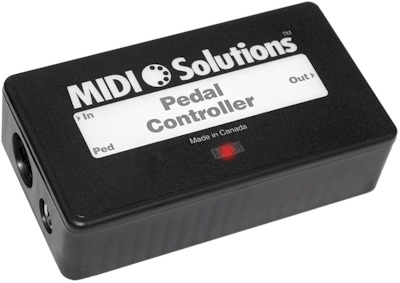MIDI Solutions Pedal Controller
on: May 14, 2014, 16:45 (from MIDIpedals.com)
Product Review: MIDI Solutions Pedal Controller
Company Website: midisolutions.com/prodped.htm
Price: $149 US (MSRP)
Rating: (4 out of 5)
Intro: We have had quite a few people asking what to do about a swell or volume pedal after they have done an organ pedal MIDI project. For the most part, we didn’t have a good answer. After using the MIDI Solutions Pedal Controller, we think we do.
MIDI pedals are easy enough to convert using the Cygnus MIDI Adapter and other adapters to wire harvested pedals from old Hammond and the like organs. There are plenty of online directions, YouTube videos and even whole websites devoted to doing this. Taking an old volume or swell pedal from an organ and wiring it to something is a little more complex as I found out. There are some serious electronics that need to be used to convert that pedal’s potentiometer into something your synth, PC or what have you can use.
My Experience: After contacting the good people at MIDI Solutions about a review unit, I bought a Moog EP-3 because I didn’t have an expression pedal to use. The EP-3 got pretty good reviews, and was fairly inexpensive at around $45 US. I wanted a well-known manufacturer and something that I know would hold up to mild use in an organ environment or would also be able to handle the antics of a guitarist in a wah-pedal setup. The EP-3 also has a switch that lets the user change from standard to reverse polarity.
We set up Apple’s MainStage with a virtual guitar amp and stomp boxes. Our EP-3 and Pedal Controller would handle the wah and volume duties. Using the Cygnus MIDI Adapter, we constructed a pedalboard of 12 stomp-box button switches and left a space for our Moog expression pedal and the MIDI Solutions Pedal Controller.
Using With A MIDI Setup: The Pedal Controller is ready to go out of the box. You just need two MIDI cables and a pedal with a 1/4” stereo jack connector. Most synth rigs and software should recognize the MIDI message sent from the Pedal Controller (CC #7, Channel Volume). Be warned, because if you are connecting to a computer, you should take care to read MIDI Solutions FAQs page about which MIDI products do not provide enough power to be used with the Pedal Controller. My first try (before I read the directions) was with a cheapie USB to MIDI cable that I bought on eBay. It works with a variety of my MIDI devices, but with the Pedal Controller, I was not able to get very good results controlling the volume or wah in MainStage. After swapping out to a Tascam US-144, the Pedal Controller worked flawlessly with the EP-3.
MainStage as with other virtual guitar amp software I’m sure, will take just about any MIDI message and use it to control whatever you need it to. In my case, using the Pedal Controller for wah or volume worked just as well. I even used it in my MIDI keyboard setup for controlling expression and volume (on two separate patches) and it worked great. We also tried an old Hammond organ swell pedal that we harvested from a spinet organ, connected to a 1/4” stereo jack, but did not have very good results with full motion of our pedal. Most likely that was due to the pedal itself not being a reliable unit. ‘
Some of the initial troubleshooting I did when I was using the cheapie MIDI to USB adapter was to change the Pedal Controller’s MIDI parameters. Using 3rd party software and the user guide, I was able to edit the MIDI parameters, but I don’t think most users will need to do this. I was told that MIDI Solutions is working on their own software for both Windows and Mac that will be released shortly. In the mean time, there are quite a few free MIDI editors available for Windows, Mac and Linux.
Conclusion: MIDI Solution’s Pedal Controller is a great product which is easy to use. If we would have had a better MIDI to USB interface to begin with, I would say our setup would have been less than five minutes. As solid as the product is in its construction, directions, and usability, I will say that I think the price is a little high for most DIYers. Sure you can order from eBay or Amazon and find them selling for less than their MSRP, but spending upwards of $125 on one is pushing the budget.
Reviewed by Terry Goyette
This review © 2018 twocargar.com
If you would like your product reviewed, please contact us via our Contact Us page.
